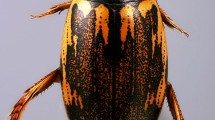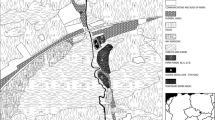Abstract
Larvae of wetland caddisflies supplement their detrital diets with animal material. In some species this supplement is obtained by preying on other caddisflies. In this study, we conducted a series of laboratory experiments to a) compare intraspecific aggression and the propensity for cannibalism among six caddisfly species that occur along a gradient from vernal to autumnal to permanent high-elevation wetlands, and b) determine the importance of cases in preventing or reducing cannibalism and intraguild predation. We predicted that cannibalism and overall levels of aggression should be highest in species that occur in temporary habitats. We found that all of the species that use temporary habitats (Asynarchus nigriculus, Hesperophylax occidentalis, Limnephilus externus, Limnephilus picturatus, Limnephilus secludens) were extremely aggressive towards and cannibalized conspecifics without cases. Species that typically occur in short-duration temporary wetlands were more aggressive than those in long-duration temporary wetlands. Cases prevented cannibalism in four of these temporary-habitat species, and reduced cannibalism among Asynarchus larvae. The latter species occurs in extremely ephemeral habitats where cannibalism provides a dietary supplement that probably facilitates emergence before drying. Asynarchus also preys on Limnephilus spp., and we found that cases dramatically reduced vulnerability to intraguild predation. Larvae of Agrypnia deflata, a species that occurs only in permanent wetlands, were least aggressive and rarely cannibalized conspecifics. Our results are consistent with the hypothesis that intraspecific aggression and the potential for cannibalism are highest in species that live in habitats with developmental time constraints. Many wetland invertebrates face developmental time constraints and selection for aggression in temporary habitats should be especially strong for taxa that rely on animal material to supplement a mainly detrital diet.
Similar content being viewed by others
Literature cited
Anderson, N. H. 1976. Carnivory by an aquatic detritivore, Clistorina magnifica (Trichoptera Limnephilidae). Ecology 57:1081–1085.
Anderson, N. H. and A. S. Cargill. 1987. Nutritional ecology of aquatic detritivorous insects, p. 903–925. In Slansky, F. and J. G. Rodriquez (eds.) Nutritional Ecology of Insects, Mites, Spiders, and Related Invertebrates. John Wiley & Sons, New York, NY, USA.
Batzer, D. P. and S. A. Wissinger. 1996. Ecology of insect communities in nontidal wetlands. Annual Review of Entomology 41: 75–100.
Batzer, D. P., R. B. Rader, and S. A. Wissinger (eds.). 1999. Invertebrates in Freshwater Wetlands of North America: Ecology and Management. John Wiley & Sons, New York, NY, USA.
Berté, S. B. and G. Pritchard. 1986. The life histories of Limnephilus externus Hagen, Anabolia bimaculata (Walker) and Nemotaulius hostilis (Hagen) (Trichoptera, Limnephilidae) in a pond in southern Alberta, Canada. Canadian Journal of Zoology 64:2348–2356.
Bowen, S. H., E. V. Lutz, and M. O. Ahlgren. 1995. Dietary protein and energy as determinants of food quality: trophic strategies compared. Ecology 76:899–907.
Day, R. W. and G. P. Quinn. 1989. Comparisons of treatments after an analysis of variance in ecology. Ecological Monographs 59: 433–463.
Dong, Q. and G. A. Polis. 1992. The dynamics of cannibalistic populations: a foraging perspective. p. 12–37. In M. A. Elgar and B. J. Crespi (eds.) Cannibalism: Ecology and Evolution Among Diverse Taxa. Oxford University Press, London, UK.
Englund, G. and C. Otto. 1991. Effects of ownership status, weight asymmetry, and case fit on the outcome of case contests in two populations of Agrypnia pagetana (Trichoptera: Phryganeidae) larvae. Behavioral Ecology and Sociobiology 29:113–120.
Giller, P. S. and N. Sangpradub. 1993. Predatory foraging behavior and activity patterns of larvae of two species of limnephilid cased caddis. Oikos 67:351–357.
Iverson, T. M. 1979. Laboratory energetics of larvae of Sericostoma personatum (Trichoptera). Holarctic Ecology 2:1–5.
Jacobsen, D. and K. Sand-Jensen. 1994. Growth and energetics of a trichopteran larva feeding on fresh submerged and terrestrial plants. Oecologia 97:412–418.
Jacobsen, D. and N. Friberg. 1995. Food preference of the trichopteran larva Anabolia nervosa from two streams with different food availability. Hydrobiologia 308:139–144.
Johansson, A. 1991. Caddis larvae cases (Trichoptera, Limnephilidae) as anti-predatory devices against brown trout and sculpin. Hydrobiologia 211:185–194.
Johansson, A. and F. Johansson. 1992. Effects of different caddisfly case structures on predation by dragonfly larva. Aquatic Insects 14:73–84.
Johansson, A. and G. Englund. 1995. A predator-prey game between bullheads and case-making caddis larvae. Animal Behavior 50: 785–792.
Ludwig, D. and L. Rowe. 1990. Life-history strategies for energy gain and predator avoidance under time constraints. American Naturalist 135:686–707.
Mackay, R. J. and G. B. Wiggins. 1979. Ecological diversity in Trichoptera. Annual Review of Entomology 24:185–208.
MacNeil, C., J. T. A. Dick, and R. W. Elwood. 1997. The trophic ecology of freshwater Gammarus spp. (Crustacea:Amphipoda): problems and perspectives concerning the functional feeding group concept. Biological Reviews 72:349–364.
Mihuc, T. B. 1997. The functional trophic role of lotic primary consumers: generalist versus specialist strategies. Freshwater Biology 37:455–462.
Nislow, K. H. and M. C. Molles. 1993. The influence of larval case design on vulnerability of Limnephilus frijole (Trichoptera) to predation. Freshwater Biology 29:411–417.
Otto, C. 1976. Habitat relationships in larvae of three Trichoptera species. Archiv für Hydrobiologie 77:505–517.
Otto, C. 1982. Habitat, size, and distribution of Scandinavian limnephilid caddisflies. Oikos 38:355–360.
Otto, C. 1983. Behavioural and physiological adaptations to a variable habitat in two species of case-making caddisfly larvae using different food. Oikos 41:188–194.
Otto, C. 1987a. Asymmetric competition for cases in Agrypnia pagetana (Trichoptera) larvae to cases of different values. Oikos 48: 253–257.
Otto, C. 1987b. Behavioural adaptations by Agrypnia pagetana (Trichoptera) larvae to cases of different values. Oikos 50:191–196.
Otto, C. and B. S. Svensson. 1980. The significance of case material selection for the survival of caddis larvae. Journal Animal Ecology 49:855–865.
Polis, G. A. 1981. The evolution and dynamics of intraspecific predation. Annual Review of Ecology Systematics 12:225–251.
Power, M. E., J. C. Marks, and M. S. Parker. 1992. Variation in the vulnerability of prey to different predators: community-level consequences. Ecology 73:2218–2223.
Pritchard, G. and S. B. Berté. 1987. Growth and food choice by two species of limnephilid caddis larvae given natural and artificial foods. Freshwater Biology 18:529–535.
Sparks, G. B. 1993. Competition and intraguild predation between two species of caddisfly (Trichoptera) larvae in permanent and semi-permanent high elevation ponds. B.S. Thesis. Allegheny College, Meadville, PA, USA.
Wellborn, G. A., D. K. Skelly, and E. E. Werner. 1996. Mechanisms creating community structure across a freshwater habitat gradient. Annual Review of Ecology Systematics 27:337–363.
Wiggins, G. B. 1973. A contribution to the biology of caddisflies (Trichoptera) in temporary pools. Life Science Contributions of Royal Ontario Museum. 88:1–28.
Wiggins, G. B. 1996. Larvae of the North American caddisflies (Trichoptera). 2nd ed. University of Toronto Press, Toronto, ON, Canada.
Wiggins, G. B. 1998. Caddisfly Family Phryganeidae (Trichoptera). University of Toronto Press. Toronto, ON, Canada.
Wiggins, G. B., R. J. Mackay, and I. M. Smith. 1980. Evolutionary and ecological strategies of animals in annual temporary pools. Archiv für Hydrobiologie Supplement 58:97–206.
Williams, D. D. 1987. The Ecology of Temporary Waters. Chapman and Hall, London, UK.
Williams, D. D. 1996. Environmental constraints in temporary fresh-waters and consequences for the insect fauna. Journal North American Benthological Society 15:634–650.
Williams, D. D., A. F. Tavares, and E. Bryant. 1987. Respiratory device or camouflage? A case for the caddisfly. Oikos 50:42–52.
Williams, D. D., and B. W. Feltmate. 1992. Aquatic Insects. CAB International, Wallingford, UK.
Winterbourn, M. J. 1971. The life histories and trophic relationships of the Trichoptera of Marion Lake, British Columbia. Canadian Journal of Zoology 49:623–635.
Wissinger, S. A. 1999. Ecology of wetland invertebrates: synthesis and applications for conservation and management. p. 1043–1086. In Batzer, D. P., R. B. Rader, and S. A. Wissinger (eds.). Invertebrates in Freshwater Wetlands of North America: Ecology and Management. Wiley & Sons, New York, NY, USA.
Wissinger, S. A., G. B. Sparks, G. L. Rouse, W. S. Brown, and H. Steltzer. 1996. Intragulld predation and cannibalism among larvae of detritivorous caddisflies in subalpine wetlands. Ecology 77: 2421–2430.
Wissinger, S. A. and L. J. Gallagher. 1999. Beaver pond wetlands in western Pennsylvania: modes of colonization and succession after drought. p. 333–362. In D. P. Batzer, R. B. Rader, and S. A. Wissinger (eds.) Invertebrates in Freshwater Wetlands of North America: Ecology and Management. John Wiley & Sons, New York, NY, USA.
Wissinger, S. A., H. H. Whiteman, G. B. Sparks, G. L. Rouse, and W. S. Brown. 1999a. Tradeoffs between competitive superiority and vulnerability to predation in caddisflies along a permanence gradient in subalpine wetlands. Ecology 80:2102–2116.
Wissinger, S. A., A. J. Bohonak, H. H. Whiteman, and W. S. Brown. 1999b. Subalpine wetlands in central Colorado: habitat permanence, salamander predation, and invertebrate communities p. 757–790. In D. P. Batzer, R. B. Rader, and S. A. Wissinger (eds.) Invertebrates in Freshwater Wetlands of North America: Ecology and Management. John Wiley & Sons, New York, NY, USA.
Wissinger, S. A., W. S. Brown, and J. E. Jannot. 2003. Caddisfly life histories along permanence gradients in high-elevation wetlands in Colorado (USA). Freshwater Biology 48:255–270.
Wissinger, S. A., J. Steinmetz, J. S. Alexander, and W. S. Brown. 2004. Larval cannibalism, time constraints, and adult fitness in caddisflies that inhabit temporary wetlands. Oecologia 138:39–47.
Zamora-Munoz, C. and B. W. Svensson. 1996. Survival of caddis larvae in relation to their case material in a group of temporary and permanent pools. Freshwater Biology 36:23–31.
Author information
Authors and Affiliations
Corresponding author
Rights and permissions
About this article
Cite this article
Wissinger, S.A., Eldermire, C. & Whissel, J.C. The role of larval cases in reducing aggression and cannibalism among caddisflies in temporary wetlands. Wetlands 24, 777–783 (2004). https://doi.org/10.1672/0277-5212(2004)024[0777:TROLCI]2.0.CO;2
Received:
Revised:
Accepted:
Issue Date:
DOI: https://doi.org/10.1672/0277-5212(2004)024[0777:TROLCI]2.0.CO;2




